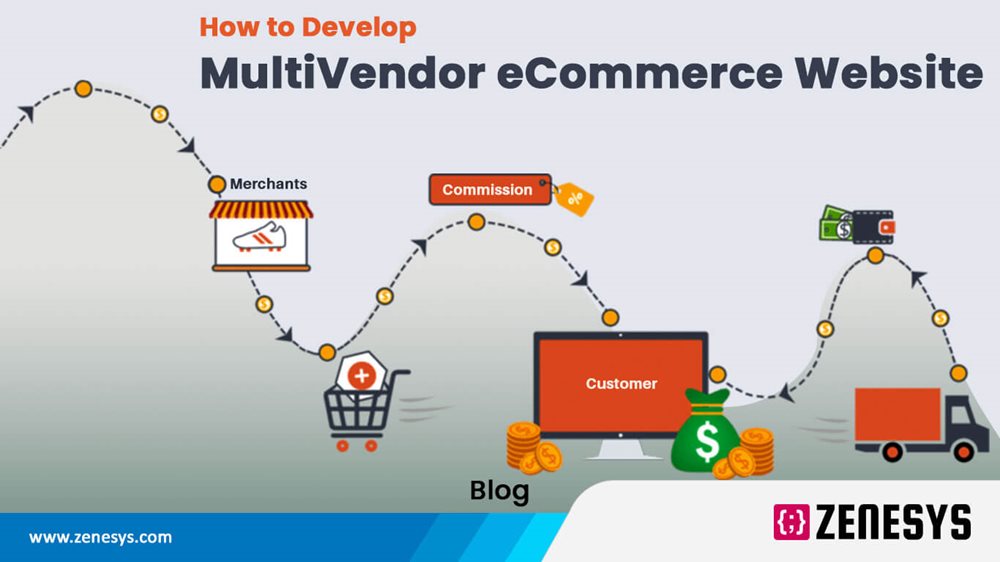But with e-commerce having grown so much over the years and has undergone so much diversification, simple online stores will not do the trick anymore.
The global eCommerce market is anticipated to hit $4.32 trillion in revenue by 2025. From 2025 to 2029, the market is projected to grow at a compound annual growth rate (CAGR) of 8.02%, eventually reaching a market volume of $5.89 trillion by 2029.
China is expected to lead with the highest eCommerce revenue, forecasted at $1.38 trillion in 2025.
By 2029, the total number of eCommerce users worldwide is expected to grow to 3.6 billion, with user penetration rising from 42.4% in 2025 to 49.1% by 2029.
Now there are two ways to hop on this trend. You are either a vendor who starts selling on a multi-vendor marketplace, or you are an ambitious merchant who wants to set up their own multi-vendor marketplace. In this article, we will go over everything you need for multi-vendor e-commerce website development in 2022.
What Is a Multi-Vendor Ecommerce Marketplace?
A multi-vendor marketplace refers to an online e-commerce portal where you can buy different products or services from different vendors on the same platform. It is a direct link between buyers and sellers. These sellers have their seller accounts, where they manage their inventory themselves and pay a commission to the marketplace.
These e-commerce services create a win-win scenario for both the seller and the marketplace. The marketplace receives inventory, whereas the seller gets customers. Although, it is the marketplace operator who carries out all the transactions. In essence, if you are planning on going through with a multi-vendor e-commerce website development, then you are trying to create a marketplace similar to Amazon or Flipkart.
Also, to survive in this competitive environment, it is of the essence that you make advanced features such as fraud detection, detailed order tracking, etc., available. Here are the different types of multi-vendor marketplaces.
● Product marketplace
● Service marketplace
● Project marketplace
● Hybrid marketplace
Multi-Vendor E-Commerce Services vs. Online Stores
Multi-vendor marketplaces is the way to go, and their benefits are undeniable. To put things into perspective, let's have a comparison. Multi-vendor marketplaces can be compared to online stores how shopping malls could be compared to individual shops of narrow focus. Multi-vendor marketplaces offer the option of sharing costs and audiences with other like-minded businesses.
In fact, according to a study conducted by BigCommerce, 48% of online shoppers directly head to a multi-vendor e-commerce website to do all their online shopping. A staggering statistic is that almost 59% of online shoppers open up Amazon whenever online shopping pops into their minds.
|
Multi-vendor Online Store |
Single-Vendor Online store |
|---|---|
|
There are multiple sellers on e-commerce marketplace. |
There is only one seller on an online store, limiting your options. |
|
Get a larger number of visitors since they are much more popular and accessible. |
Needs to attract users by making use of digital marketing tactics. |
|
Vendors are given the option to choose their own business model or membership plan. |
The seller has to keep investing in the store on a regular basis to keep it afloat. |
|
Multi-vendor marketplaces already enjoy the customers trust. |
Online stores have to build and earn customer trust and reputation from scratch. |
|
Offers detailed buyer protection programs. |
Online stores have their own set of policies for buyer protection programs. |
Also Read: How Much Does It Cost To Develop An Ecommerce App?
Who Benefits from a Multi-Vendor eCommerce Website?
Multi-vendor websites like Amazon, Etsy, and Flipkart have changed the way people shop and sell online.
But what exactly is a multi-vendor website? And who really gains from it?
Who Is It For?
Here’s who gets the most out of a multi-vendor website:
- Entrepreneurs or businesses who want to run a marketplace without handling inventory
- Sellers or vendors who want to reach more customers without building their own website
- Buyers looking for more variety, better deals, and convenience
Let’s look at each group one by one.
Why Should You Build a Multi-Vendor Marketplace?
If you’re the owner of the platform (like running the next Etsy or niche marketplace), here’s why it makes sense:
- No Inventory Hassles
You don’t need to stock products or handle delivery. Sellers take care of that. - Recurring Commission Revenue
Every time a vendor sells something, you earn a small cut—whether it’s a flat fee or a percentage. - Scalable Business Model
Adding more vendors means more products and more potential sales. It grows without you adding every single item yourself. - Variety Attracts More Buyers
Having a wide range of products from different vendors increases your chances of attracting traffic. - Less Operational Stress
Sellers handle their listings, pricing, shipping, and returns. Your focus is just the tech and management side.
How Sellers Benefit
Many sellers today want a shortcut to getting online without the cost and work of building a full eCommerce site. A multi-vendor platform gives them that shortcut.
Here’s how it helps:
- Instant Access to Traffic
They get exposure from a larger pool of buyers who already trust the platform. - Lower Costs
No need to invest in web hosting, design, or custom development. Just sign up and start listing. - Brand Presence
Even within someone else’s marketplace, sellers can usually build branded profiles, add product images, and get reviews. - Tools to Manage Sales
They get access to vendor dashboards to manage inventory, pricing, offers, and orders without needing coding knowledge. - Built-In Marketing Features
Some platforms even offer promotions, ads, or newsletter features that help sellers reach more customers.
Bonus tip: If the platform offers integrations with payment gateways, logistics, or analytics tools—sellers get a full setup with little tech know-how.
Why Buyers Love Multi-Vendor Sites
For customers, multi-vendor platforms are easy, efficient, and often cheaper. Here’s why:
- Wider Selection
They can find thousands of products, brands, or sellers in one place—whether it's electronics, handmade items, or even groceries. - Easy Comparisons
Buyers can compare prices, read reviews, check delivery times, and choose what suits them best. - More Competitive Pricing
Because many sellers are offering similar products, prices tend to be better. - Trust and Support
Reputable marketplaces often have buyer protection, return policies, and helpful customer service. - One-Stop Shopping
Buyers can shop from multiple sellers in one checkout, which saves time and effort.
“I was able to buy a phone case, handmade soap, and a yoga mat—all in the same order, from different sellers. That’s why I keep coming back.” – a happy buyer
How To Create a Multi Vendor Ecommerce Website?
Before you go ahead and try your hand at multi-vendor e-commerce website development, you must first focus on some basics. Then, find the answers to these below-mentioned questions, and once you have them, you can comfortably proceed with the development of your e-commerce marketplace.
● What sort of target audience are you catering to?
● What is going to be your specialization?
● Have you figured out your financial model yet?
● What about your management type?
● What are the various products you plan on selling?
Once you have figured out the answers to these five vital questions, you can now proceed with your multi-vendor e-commerce website development. Just use one of these methods to achieve your objective.
CODING FROM SCRATCH
If you want to build an e-commerce services website right out of your imagination and straight from scratch, you can hire your team of coders to develop it. You, and only you, will have complete access to the underlying code, owing nothing to third-party software. Additionally, you have complete ownership of licensing.
But the pitfall to this method is that it can be time-consuming and expensive. Coding from scratch might cost you somewhere north of $50,000. Besides, building a platform that can handle all transitions efficiently and securely can be another task. On top of that, adding custom features and experimenting can burn even bigger holes in your pockets.
WEBSITE BUILDER
Another way of going about building your e-commerce marketplace is making use of a website builder. This is a much affordable option, and you can use e-commerce tools such as Magneto or Shopify. Use e-commerce CMS such as Joomla or WordPress to build a website that caters to your specific business needs. Website builders also offer extensive customization options.
Using a website builder might be a very affordable option if you can handle plugins and e-commerce tools. For those who want a more streamlined solution, starting a Shopify store provides an all-in-one platform with built-in features to manage products, payments, and marketing without heavy technical work. Building a multi-vendor e-commerce service via a website builder can cost around $20,000.
NON-CODE MARKETPLACE BUILDER
Software-as-a-service and Marketplace-as-a-service can come in handy when you are trying to build a website with no code. This method is fast, efficient, and offers one of the best UX experiences. On top of that, it requires minimal investment, and it is not that difficult to manage the website by yourself. If you want to create a no-code website, it can be done within $5,000.
CREATING THE WEBSITE ON TOP OF AN API
If you choose to build an e-commerce marketplace on top of an API, then you cannot lay a lot of focus on the basics. Instead, your main focus has to be adding additional functionality and new useful features. Creating a website on top of an API is cheaper than coding from scratch, a lot more customizable than a no-code tool, and offers integration with third-party software.
Although, the minimum requirement for multi-vendor e-commerce website development on top of an API is the presence of a strong team of API developers by your side. This method will cost you less than $10,000.
Planning to build a multi-vendor eCommerce platform?
Zenesys can help you launch a scalable and feature-rich eCommerce solution tailored for vendors, sellers, and shoppers—all in one place.
Build Your eCommerce Store TodayFinal Verdict
Here's everything you need to know about the basics and development of a multi-vendor e-commerce website. There's no single best way of developing a marketplace. If you have a sizable budget, you can always choose to code from scratch. Otherwise, use any other methods according to your comfort and understanding.
Get in touch with the specific needs of your business, including budget size, approach, etc., and choose the e-commerce website development that ticks all the right boxes for you and your enterprise.
.jpg?lang=en-US&ext=.jpg)

.webp?lang=en-US&ext=.webp)

.webp?lang=en-US&ext=.webp)

